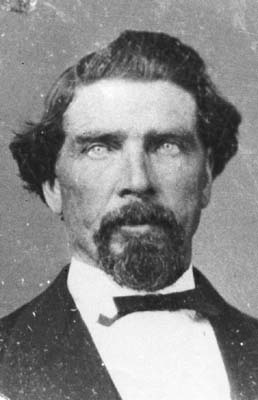
CITY MARSHAL JAMES McCOY
SDCMO 1856 - 02/1869
08/21/1821 - 1895
Smallpox killed several hundred people countywide, mostly Indians, but it didn’t last long and within a year San Diego was faced with another problem. Cave Couts was starting to make an issue out of the fact there was a shortage of quality pigs in town. Now a bunch of dead Indians were one thing, but lack of decent meat was another. Being an avid pork eater and a man of action, Couts organized a committee to raise money to buy a quality-breeding sow from the east coast. Within weeks the group raised more than $200 and placed an order for a pig.
The sow arrived several months later and was quickly bred with a local hog. The town’s people were justifiably excited when the she later produced a fine litter of 8 healthy piglets. As soon as they were weaned, the piglets were kept in a backyard pen in Old Town.
For weeks everything was fine until one of the piglets came up missing. Several nights later another piglet vanished. Townspeople held a meeting and figuring it was the Indians stealing the pigs, a guard was posted in the house next door to the pen. Shortly after midnight, the guard heard squealing and saw a shadowy figure running away. The guard took aim with his rifle and fired, dropping the pig thief with one shot. When he caught up to the body, he rolled it over and saw it was in fact an Indian, a very dead Indian.
The next morning attorney George Pendleton and others got together and decided the shooting of the Indian was murder. Pendleton contacted Marshal McCoy and demanded the gunman be arrested. The marshal was reluctant at first as the gunman was a personal friend, but he was bound by law to make the arrest.
Trial was held in the Estudio House with Pendleton serving as prosecutor. The defendant told the court he was justified in shooting the Indian as the law allowed someone who was stealing a horse to be shot and a pig wasn’t much different. Undaunted, Pendleton spelled out his case to the jury telling them the life of an Indian was worth more than that of a pig. After hearing all of the evidence Judge Thomas Bush sent the jury into another room for deliberations. Bush ordered Marshal McCoy outside the room to guard the jurors. After an hour of deliberations the jury foreman came to the door and told McCoy they had reached a verdict. “What is it?” asked the marshal. “Guiltier than Hell” responded the foreman. The marshal looked at the foreman and told him, “Well you had better go back into that room and do some more deliberating because you haven’t thunk about the case long enough.” After several times of being sent back for more deliberations, the foreman finally got the message and returned with a not guilty verdict. Marshal McCoy let the jury out of the room and the gunman out of his shackles.
In 1867 McCoy tried his hand in the real estate market spending $4,000 to purchase 20,000 acres in what is now Rancho Bernardo. It turned out to be a good investment. In 1869 he sold the property for $35,000.
Despite being well off financially, McCoy was not married. He shared his spacious home with Tom Fox, one of his deputies. The two men had an odd relationship and every morning they would engage in a quick round of bare fist boxing. The loser of the match would then have to fix the winner breakfast.
By the late 1860’s McCoy could see his days as marshal were coming to an end. The trustees had made it clear they were more interested in having the town’s top lawman acting more as a health inspector than a policeman. With that he submitted his resignation in February 1869.

James McCoy was born in Ireland on August 21, 1821, and came to the United States in 1842. In 1849 he joined the US Army and was sent to San Diego. For the next two years he was stationed at San Luis Rey near Oceanside where he found himself involved in several skirmishes with Indians.
In 1858 McCoy settled in San Diego and was elected County Assessor a year later.
In 1861 he decided to try his hand at something a little more adventurous and ran a successful campaign for sheriff. A year later the Board of Trustees chose him to be city marshal.
In 1862 the US was heavily involved in the Civil War. Because of its remote location San Diego was able to stay removed from the fighting but was not without problems.
In January 1863 a Smallpox epidemic had taken hold of San Diego.
Fearing spread of the disease and looking for someone to blame, the trustees ordered Marshal McCoy to enforce a law requiring all Indians and Mexicans to remain at least ½ mile out of town.
It wasn’t the first time Indians and Mexicans were the victims of blatant discrimination nor was it to be the last.
THE THIN BLUE LINE
